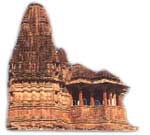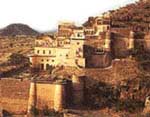
RAJGARH
|
Located
22 miles south of Alwar, among the prettily wooded
valleys, characteristic of this part of Rajasthan,
is the old hill top Fort Of Rajgarh. It was built
by Raja Pratap Singh, the founder of the State of
Alwar and often referred to as the "Bismarck of Alwar".
In 1771 this fort was the site of the old capital
before the new capital was set up at Alwar.
|

An old photograph of Alwar |
It was later turned into a summer
palace. A 19th century British traveler described this valley
as "A Perfect Earthly Paradise". There the walls of the
well-kept fort of Rajgarh are picturesquely perched on a
hill which rises out of a green and fertile tree embowered
valley. Today the fort is somewhat dilapidated. But still
worth visiting, with its curious fading frescos, its old
Sheesh Mahal and its tales of secret passages. At the bottom
of the hill is a town with narrow alley walls and old havelis
set amid the citrus groves. The entire surrounding region
is dotted with the ruins of old hill forts, standing like
silent sentinels.
BHANGARH
|
On
the outskirts of Sariska Tiger Reserve, 33 miles from
its gate, lies the splendid, old ruined town of Bhangarh
- its crumbling pavilion, walls and temple silent
in the wilderness, against the backdrop of the forested
hills. Built in the early 17th century by Raja Madho
Singh I this was once a city of ten thousand homes.
|

Temple at Bhangarh |
The medieval bazaar recently restored, is fascinated and
evocative of the town's ancient prosperity. Beyond it, at
the foot of the hills, lie the ruins of the old palace and
Someshwar Temple, with its fine carvings and its tank nearby
is the temple of Gopinath with its carved pillars and corbel
dome. Not far away is another ruined monument now indelicately
labeled "RANDIYON KA MAHAL" ("Palace of the Prostitute").
Over looking all of this is a cupola on the hills from where,
if you are adventurous, you can get a great view of the
superb landscape .According to legend the town was cursed
by an evil magician and had to be abandoned. The curse is
still believed to operate.
BAIRAT
|
The village of Bairat, 40 miles south-west of Alwar
has a remarkably rich history, boasting monuments
and legends from at least three different epochs.
Here on a low hills are the ruins of a 3rd century
BC Buddhist chaitya or chapel the oldest freestanding
structure anywhere in India You can see the foundations
of the circular building and the niches for the twenty-six
octagonal wooden pillars that once supported it.
|
 A
cityscape view of Bairat
A
cityscape view of Bairat |
Among the huge rock overhead are the remains of a monastery.
Not far away is a rock edict of Emperor Ashoka, also from
the 3rd century, indicating that this was an important town
in that era. However, the history of Bairat goes back even
further, to the time of the epic of Mahabharata around 1100
BC and this is said to have been the site of the great city
of Viratnagar where the Pandavas heroes, with their wife
Draupadi, Spent the thirteen year of their exile. Nothing
remained of the ancient city, although archaeological finds
do indicate the area's great antiquity. Nearby is a little
known neglected but charming 16th century chhatri where
Emperor Akbar is said to have hunted and stayed overnight
en route on his pilgrimage to Ajmer(It is worth seeing for
the elegant murals that adorn its chambers).